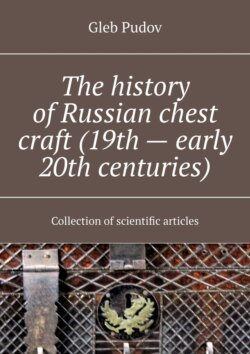Читать книгу The history of Russian chest craft (19th – early 20th centuries). Collection of scientific articles - Глеб Пудов - Страница 2
Foreword
ОглавлениеThe chest has been known in Russia since ancient times. Even in the annals and Novgorod birch bark letters there are references to chests and caskets. Many of them are admirable works of art. By the 19th century, Russian chest craft had turned into a powerful industry, in which hundreds of craftsmen were employed.
The history of chest production has been little studied until recently. There were only a few scientific articles and small notes in local newspapers. However, the situation has recently changed: monographs have been published in the major centers of chest production in Russia, as well as many scientific articles, the conclusions of which are based on previously unknown archival information. These works deal with many aspects of the chest production: the history of specific workshops, branding features, the specifics of certain types of chests and caskets, biographies of people who explored the craft in the 19th century, etc. But all of them were published in Russian and are known only to a narrow circle of local specialists. For foreign researchers, the history of Russian chest production remains terra incognita. Until now, information about it has hardly gone beyond the geographical borders of Russia.
This edition is the first attempt to «cut a window to Europe». As soon as the book is available in foreign libraries, it will enable Western scholars to get acquainted with the history of the Russian chest.
Gleb Pudov summarized the experience of many years of research on chest production in Russia in his monograph. The sections of the book present and analyze the activities of various Russian centers of the production of chests in the 19th – early 20th centuries (Russian North, Urals, Murom district, Vyatka province, local centers of craft). The illustrative material makes the author’s assertions convincing.
The main conclusions of the study are substantiated by extensive historiography and a large set of sources (archival data, museum specimens and field surveys of preserved objects).
After being acquainted with this book a foreign reader will get an idea about the Russian chest industry. It will become apparent that the products of each center had differences. They were evident in the appearance of chests and caskets. In his monograph Gleb Pudov emphasizes that the masters were the bearers of the traditions that had developed in a particular region. Therefore, as a rule, the artistic design of their products coincided with the products of other handicraftsmen: manufacturers of painted trays, wooden utensils, etc. The chest makers used materials and techniques that were widespread in their region, guided by the preferences of representatives of specific social strata.
So, in the eyes of the European reader, the Russian chest can appear not only as a local artistic phenomenon, but also as part of the world arts and crafts.
Natalia M. Shabalina, Doctor of Arts, Professor, South Ural State Humanitarian-Pedagogical University (Chelyabinsk, Russia); e-mail: nat.shabalina@mail.ru
